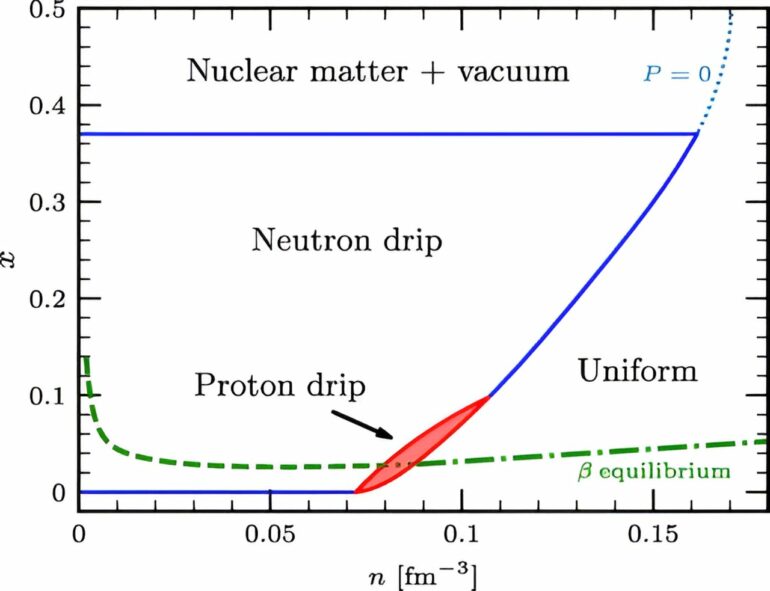Neutron stars are extreme and mysterious objects that astrophysicists cannot see inside. With a radius of around 12 kilometers, they can have more than twice the mass of the sun. The matter in them is packed up to five times as densely as in an atomic nucleus; with black holes, they are the densest objects in the universe.
Under extreme conditions, matter can assume exotic states. One hypothesis is that the building blocks of atomic nuclei—protons and neutrons—deform into plates and strings, similar to lasagna or spaghetti, which is why experts term this “nuclear pasta.”
Researchers at the Department of Physics at TU Darmstadt and the Niels Bohr Institute in Copenhagen have now adopted a new theoretical approach to investigate the state of nuclear matter in the inner crust of neutron stars. They showed that both neutrons and protons can “drip out” of atomic nuclei and stabilize the “nuclear pasta.” Their findings are reported in Physical Review Letters.
Neutron stars are formed when massive stars explode in a supernova: while the outer shells of the star are hurled into space, its interior collapses. The atoms are literally crushed by the massive gravitational force. Despite their repulsion, the negatively charged electrons are pressed so close to the positively charged protons in the atomic nucleus that they are transformed into neutrons.
The strong nuclear force then prevents further collapse. The result is an object that consists of around 95% neutrons and 5% protons—a “neutron star.”
The Darmstadt researchers led by Achim Schwenk are experts in theoretical nuclear physics, with neutron stars being one of their research interests. In their current work, they focus on the crust of these extreme objects. Matter in the outer crust is not as dense as in the interior and there are still atomic nuclei.
As the density increases, an excess of neutrons develops in the atomic nuclei. Neutrons can then “drip” out of the nuclei, a phenomenon known as “neutron drip.” Atomic nuclei therefore “swim” in a kind of neutron sauce.
“We asked ourselves whether protons can drip out of the nuclei as well as,” says Achim Schwenk. “The literature was not clear on this question,” continues the physicist. The team with Jonas Keller and Kai Hebeler of TU Darmstadt and Christopher Pethick from the Niels Bohr Institute in Copenhagen has calculated the state of nuclear matter under the conditions in the neutron star crust.
Unlike before, they directly calculated its energy as a function of the proton fraction. In addition, they included the pairwise interactions between particles in their calculations as well as those between three nucleons.
The method was successful: The researchers were able to demonstrate that protons in the inner crust also drip out of nuclei. So “proton drip” does actually exist. This phase consisting of protons coexists with the neutrons.
“We were also able to show that this phase favors the phenomenon of nuclear pasta,” says Schwenk. Thanks to the protons sprinkled into the “sauce,” the nucleons can better exist in spaghetti and lasagna shapes. This enabled the team to refine the image of nuclear matter in the crust of neutron stars.
“The better we can describe neutron stars, the better we can compare with astrophysical observations,” says Schwenk. Neutron stars are difficult to grasp astrophysically. For example, we know their radius only indirectly from gravitational effects on another neutron star. Moreover, other phenomena, such as pulsating radio emission from neutron stars, can be observed.
The team’s result improves the theoretical understanding of neutron stars, and contributes to gaining new insights into these mysteries of the universe from astrophysical measurements.
More information:
J. Keller et al, Neutron Star Matter as a Dilute Solution of Protons in Neutrons, Physical Review Letters (2024). DOI: 10.1103/PhysRevLett.132.232701
Provided by
Technische Universitat Darmstadt
Citation:
Researchers predict new phase in neutron stars that favors ‘nuclear pasta’ (2024, July 8)



